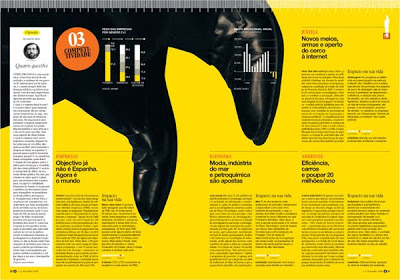Course on Google Newsroom! Media Revolution
Time of Troubles can be very productive on ideas. In my free time I reflected on the topic of mixed editions, harmoniously combining print and web directions. Once the idea captured me, I decided to share it with you and discuss it.
About the combined editions have been talking for a long time, the most famous example offered by Ifra . The other is the Daily Telegraph newspaper. Looks frightening, isn’t it?

But very often the theoretical proposals for the organization of such editorial offices are faced with the reality in which the vast majority of print journalists have very little experience with the web. If you ask them to write material for the web and print, they will start rushing around trying to adapt the material for two different media. We have two blocks:
1) The web is not a pipe into which you can merge any type of content. Very often, articles for printing are not suitable for the web or mobile devices. It is enough to remember that on the site LeMonde.fr printed articles make up 30% of the published content, but at the same time only 15% of the site’s audience reads them. You can not just write, and then send the text in the tube. When creating content, you must take into account the environment in which it will be distributed.
The same mistake is made today with respect to mobile phones, when they are trying to simply copy the content created for desktop computers there.
')
2) Journalists have become schizophrenics. They became “ two-media ”, they work like two jobs, that is, for them it means doing the work twice . As a result, they continue to work, subconsciously still focusing on the printed platform.
So we need to discard this idea by simply merging the print and web editions and make a choice - go where the information lives, where the writers and readers are connected and included in a single process. It is necessary to create such an editorial office, "where everything happens," one that is located right on the web. This is the heart of the information system. The rest is visibility.
Why the web? Because the era of Google in the yard. It spawned and proved the need for so-called online journalism. That journalism, which is not limited to the production of content, but becomes a continuing process based on the strength of the network (information fragmentation, new rhythms, user content ...) in the production and dissemination of information.
With this approach, you will get more than one “two-media” edition, not two, but three, which I would break into 2 subgroups:
- production-oriented journalism (Google edition, Google Newsroom, Google Newsroom)
- curator journalism (curation oriented) (community management and editing)
Please note, I do not use the word "journalist", I write "journalism." Here journalism is viewed not as a profession, but as a pure function, in which the basic meaning comes down to sharing journalistic skills with non-professionals.
Take for example the newspaper. Let it be called "Hope."
- 100,000 copies per day
- 1 €
- 36 pages
- print version: 85 journalists + 7 editors
- web edition: 7 journalists + 1 community manager
Total, 100 journalists. Great edition. And in no field there is no success. Not enough people on the web, and too few in the newspaper.
Now imagine a new version. All the same, our 100 journalists, but now the editors are focused on the “digital” direction, which will make it successful on the web and mobile platforms.
At the same time, “Nadezhda” will publish a paper newspaper of the highest quality, which will help raise sales and, possibly, price. At the same time, suddenly money will earn more.

Production-oriented journalism (Google Edition, Google Newsroom, Google Newsroom)
Consists of 80 journalists, but also includes other journalistic content, blogging and user-generated content, managed by your publication. We divide your 80 journalists into 10 production divisions, i.e. on thematic clusters. Each of them becomes a separate media company, it may even have its own name and be controlled (or not) by its own manager. It includes: 8 journalists, bloggers, a community + 1 marketer + 1 responsible for sales (these two can serve several clusters simultaneously).
Each cluster can have its own editor and community manager.
(And it could also be divided into 3 clusters of 16 journalists each and 3 clusters of 10 journalists each, etc.)
Production-oriented journalism will appear in each cluster. The main question is: if everyone works with the same information on the network, how do I personally benefit?
Then we get the following:
- Reporters (journalists + bloggers): they do not keep track of topics, do not reprint news agencies, they create their own, original materials.
They go to the scene or get information from the network. They publish in a different rhythm: they tweet in real time, publish articles, videos, data, conduct investigations ... In addition, they can coordinate the work of the community, bloggers, users, with whom they produce news.
- curators (journalists + non-professionals): he keeps track of topics, selects, checks, edits live all that suits them from the network and other media. They link different content, they make it so easy to get news.
- columnists (bloggers, journalists, experts): they plant discussions, give different points of view on the question.
Curator journalism (curation oriented) (community management and editing)
- A team of 10 super editors is responsible for the material on 36 pages. Each of them only works on 3-4 pages, but they have the real work of the old school editor. They take the content, which produces Google edition, and give him life in their own way. Their task is to make the material more readable and intuitive. They do everything with paper that the web cannot. Here is a clear example of what a newspaper is capable of (in this case, the Portuguese newspaper “I”).

With the help of super editors, each “digital” cluster can make a special paper release.
- A team of 10 journalist moderators and journalistic analysts is responsible for managing information on the web and mobile. In fact, they are responsible for the convenience of the consumption of produced content. They care about the quality of user engagement.
In addition, they are working to ensure that the collected information is embodied in the form of databases (for example, as in the New York Times ).

And they organize content into sections, collect everything you need on one page (posts, links, tweets, raw data, etc.). The newspaper Huffington Post very well copes with this task on its pages "Important News" .
The result of all this is a connected, powerful, completely rebuilt version - Google version.
With 80 journalists on board, this will be the first online edition in France.
Now imagine the same thing, only out of 200 journalists who now work in a large national newspaper.
You ask me: Will your 80 journalists be able to go online? In most editions, the level of use of web technologies is close to zero.
I think yes. Interferes with two-media thinking, schizophrenia. But now, if my message and environment are clear, if the journalist is properly trained, he will give us good journalism.
The most lazy can have fun, trying to find creative forms of the editor.
This model can be easily reproduced on radio and television.
And what do you think?
About the combined editions have been talking for a long time, the most famous example offered by Ifra . The other is the Daily Telegraph newspaper. Looks frightening, isn’t it?

But very often the theoretical proposals for the organization of such editorial offices are faced with the reality in which the vast majority of print journalists have very little experience with the web. If you ask them to write material for the web and print, they will start rushing around trying to adapt the material for two different media. We have two blocks:
1) The web is not a pipe into which you can merge any type of content. Very often, articles for printing are not suitable for the web or mobile devices. It is enough to remember that on the site LeMonde.fr printed articles make up 30% of the published content, but at the same time only 15% of the site’s audience reads them. You can not just write, and then send the text in the tube. When creating content, you must take into account the environment in which it will be distributed.
The same mistake is made today with respect to mobile phones, when they are trying to simply copy the content created for desktop computers there.
')
2) Journalists have become schizophrenics. They became “ two-media ”, they work like two jobs, that is, for them it means doing the work twice . As a result, they continue to work, subconsciously still focusing on the printed platform.
So we need to discard this idea by simply merging the print and web editions and make a choice - go where the information lives, where the writers and readers are connected and included in a single process. It is necessary to create such an editorial office, "where everything happens," one that is located right on the web. This is the heart of the information system. The rest is visibility.
Why the web? Because the era of Google in the yard. It spawned and proved the need for so-called online journalism. That journalism, which is not limited to the production of content, but becomes a continuing process based on the strength of the network (information fragmentation, new rhythms, user content ...) in the production and dissemination of information.
With this approach, you will get more than one “two-media” edition, not two, but three, which I would break into 2 subgroups:
- production-oriented journalism (Google edition, Google Newsroom, Google Newsroom)
- curator journalism (curation oriented) (community management and editing)
Please note, I do not use the word "journalist", I write "journalism." Here journalism is viewed not as a profession, but as a pure function, in which the basic meaning comes down to sharing journalistic skills with non-professionals.
Take for example the newspaper. Let it be called "Hope."
- 100,000 copies per day
- 1 €
- 36 pages
- print version: 85 journalists + 7 editors
- web edition: 7 journalists + 1 community manager
Total, 100 journalists. Great edition. And in no field there is no success. Not enough people on the web, and too few in the newspaper.
Now imagine a new version. All the same, our 100 journalists, but now the editors are focused on the “digital” direction, which will make it successful on the web and mobile platforms.
At the same time, “Nadezhda” will publish a paper newspaper of the highest quality, which will help raise sales and, possibly, price. At the same time, suddenly money will earn more.

Production-oriented journalism (Google Edition, Google Newsroom, Google Newsroom)
Consists of 80 journalists, but also includes other journalistic content, blogging and user-generated content, managed by your publication. We divide your 80 journalists into 10 production divisions, i.e. on thematic clusters. Each of them becomes a separate media company, it may even have its own name and be controlled (or not) by its own manager. It includes: 8 journalists, bloggers, a community + 1 marketer + 1 responsible for sales (these two can serve several clusters simultaneously).
Each cluster can have its own editor and community manager.
(And it could also be divided into 3 clusters of 16 journalists each and 3 clusters of 10 journalists each, etc.)
Production-oriented journalism will appear in each cluster. The main question is: if everyone works with the same information on the network, how do I personally benefit?
Then we get the following:
- Reporters (journalists + bloggers): they do not keep track of topics, do not reprint news agencies, they create their own, original materials.
They go to the scene or get information from the network. They publish in a different rhythm: they tweet in real time, publish articles, videos, data, conduct investigations ... In addition, they can coordinate the work of the community, bloggers, users, with whom they produce news.
- curators (journalists + non-professionals): he keeps track of topics, selects, checks, edits live all that suits them from the network and other media. They link different content, they make it so easy to get news.
- columnists (bloggers, journalists, experts): they plant discussions, give different points of view on the question.
Curator journalism (curation oriented) (community management and editing)
- A team of 10 super editors is responsible for the material on 36 pages. Each of them only works on 3-4 pages, but they have the real work of the old school editor. They take the content, which produces Google edition, and give him life in their own way. Their task is to make the material more readable and intuitive. They do everything with paper that the web cannot. Here is a clear example of what a newspaper is capable of (in this case, the Portuguese newspaper “I”).

With the help of super editors, each “digital” cluster can make a special paper release.
- A team of 10 journalist moderators and journalistic analysts is responsible for managing information on the web and mobile. In fact, they are responsible for the convenience of the consumption of produced content. They care about the quality of user engagement.
In addition, they are working to ensure that the collected information is embodied in the form of databases (for example, as in the New York Times ).

And they organize content into sections, collect everything you need on one page (posts, links, tweets, raw data, etc.). The newspaper Huffington Post very well copes with this task on its pages "Important News" .
The result of all this is a connected, powerful, completely rebuilt version - Google version.
With 80 journalists on board, this will be the first online edition in France.
Now imagine the same thing, only out of 200 journalists who now work in a large national newspaper.
You ask me: Will your 80 journalists be able to go online? In most editions, the level of use of web technologies is close to zero.
I think yes. Interferes with two-media thinking, schizophrenia. But now, if my message and environment are clear, if the journalist is properly trained, he will give us good journalism.
The most lazy can have fun, trying to find creative forms of the editor.
This model can be easily reproduced on radio and television.
And what do you think?
Source: https://habr.com/ru/post/288578/
All Articles